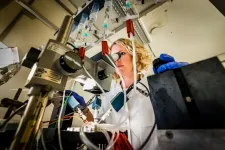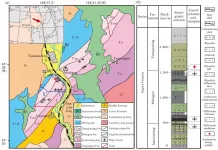Preclinical study suggests new approach to reduce COVID-19 death among the elderly
2021-06-08
(Press-News.org) MINNEAPOLIS/ST. PAUL (06/08/2021) -- New research from the University of Minnesota Medical School and colleagues at the Mayo Clinic reveals a possible new approach to preventing death and severe disease in elderly people infected with SARS-CoV-2.
The researchers demonstrated in a preclinical study that senolytic drugs significantly reduced mortality upon infection from a beta-coronavirus closely related to SARS-CoV-2 in older mice. The study published in Science was co-led by Laura Niedernhofer, MD, PhD and Paul Robbins, PhD, both professors in the Department of Biochemistry, Molecular Biology and Biophysics and co-directors of the Institute on the Biology of Aging and Metabolism at the U of M Medical School, and Sara Hamilton, PhD, assistant professor in the Department of Laboratory Medicine and Pathology.
Senescent cells -- which are cells in the body that are damaged -- contribute to inflammation, multiple chronic diseases and age-related loss of resilience, and they accumulate in our body as we age. Senolytic drugs, previously co-discovered by the U of M Medical School and the Mayo Clinic researchers, selectively remove senescent cells from the body.
The COVID-19 pandemic has revealed the pronounced vulnerability of the elderly and chronically-ill to morbidity and mortality induced by SARS-CoV-2. The research team sought to discover why older people are more vulnerable to these adverse outcomes. The team hypothesized it was senescent cells and removing them with senolytics would dial back inflammation and enable an improved response to viral infection.
"We wanted to determine if therapeutically targeting fundamental aging mechanisms, such as cellular senescence, could reduce morbidity and mortality following viral infection," said Christina Camell, PhD, an assistant professor in the Department of Biochemistry, Molecular Biology and Biophysics, and a first author of the study.
The researchers found that older mice exposed for the first time to a mouse beta-coronavirus experienced nearly 100% mortality, whereas young mice barely got sick. When they treated the older mice with senolytic drugs following infection, their survival rate increased to 50%. The senolytic drugs reduced mortality, cellular senescence and inflammatory markers and increased anti-viral antibodies.
"We have been working on a new approach to help the elderly remain healthy, which is to find therapeutics to treat aging rather than treating each individual disease associated with old age. The fact that senolytics worked to protect old organisms from a viral infection proves that approach is accurate," Robbins said. "By getting rid of a piece of aging biology, senescent cells, with senolytics, the older mice were able to withstand the stress of infection. This suggests that reducing the burden of senescent cells in ill or elderly individuals could improve their resilience and reduce their risk of dying from COVID-19."
These results in mice supported the initiation of two clinical trials to reduce mortality in elderly COVID-19 patients. The team also plans to study if senescent cells contribute to the long-hauler effect in many COVID-19 survivors.
INFORMATION:
This work was supported by the National Institutes of Health, the University of Minnesota Clinical and Translational Science Institute, the University of Minnesota Medical School and the Medical Discovery Team on the Biology of Aging, The Irene Diamond Fund/American Federation on Aging Research Postdoctoral Transition Award, the Fesler-Lampert Chair in Aging Studies, the AFAR Junior Faculty Award, the Paul F. Glenn Center for Biology of Aging Research at Mayo Clinic, the Glenn Foundation, the Connor Fund, Robert J. and Theresa W. Ryan and the Noaber Foundation.
About the University of Minnesota Medical School
The University of Minnesota Medical School is at the forefront of learning and discovery, transforming medical care and educating the next generation of physicians. Our graduates and faculty produce high-impact biomedical research and advance the practice of medicine. We acknowledge that the U of M Medical School, both the Twin Cities campus and Duluth campus, is located on traditional, ancestral and contemporary lands of the Dakota and the Ojibwe, and scores of other Indigenous people, and we affirm our commitment to tribal communities and their sovereignty as we seek to improve and strengthen our relations with tribal nations. For more information about the U of M Medical School, please visit med.umn.edu.
ELSE PRESS RELEASES FROM THIS DATE:
2021-06-08
A new tool developed by the University of Cordoba, in collaboration with the Nuclear Medicine Unit at the Hospital Reina Sofía, could allow healthcare personnel to diagnose different degrees of Parkinson's, a disease that, according to World Health Organization (WHO) data, affects 7 million people worldwide.
To date, according to AYRNA group researcher Javier Barbero, "most diagnoses only determine whether or not the patient suffers from this disease." The research team has developed a system that makes it possible to specify the phase it is in, distinguishing between four different ones, based on severity.
Specifically, this new methodology ...
2021-06-08
New molecules, developed by researchers at Linköping University, have promising properties as possible drugs against epilepsy. A study published in the journal Epilepsia shows that several of the molecules have antiseizure effects.
In people with epilepsy, the nerve cells in the brain become overactive, causing epileptic seizures.
"More than 60 million people in the world have epilepsy. A third of them still experience seizures despite taking medication, so there is a pressing need for new types of drugs", says Nina Ottosson, principal research engineer in the Department of Biomedical and Clinical Sciences, Linköping ...
2021-06-08
A new robot - named WomBot - that can be used to explore and study wombat burrows is presented in a study published in the journal SN Applied Sciences.
Wombats reside and sleep in burrows and occupy a different burrow every four to ten days. Parasitic mites that cause sarcoptic mange, a serious disease affecting wombats, are thought to be transmitted when wombats occupy each other's burrows but it has not been clear whether conditions within burrows promote this transmission.
Researchers from La Trobe University and the University of Tasmania, Australia developed WomBot in order ...
2021-06-08
For the first time, a unique study conducted at Lund University in Sweden has tracked the meteorite flux to Earth over the past 500 million years. Contrary to current theories, researchers have determined that major collisions in the asteroid belt have not generally affected the number of impacts with Earth to any great extent.
Researchers have been studying geological series since the 19th century in order to reconstruct how flora, fauna and the climate have changed over millions of years. Until now, however, almost nothing has been known about ancient meteorite flux - which makes sense since impact is rare, and the battered celestial bodies quickly break down as they encounter Earth's oxygen. A new study published in PNAS shows how researchers in Lund ...
2021-06-08
New insight on the link between a gene called SORBS2 and congenital heart disease has been published today in eLife, with findings that may help explain the cause of the disease in some patients.
Some people with congenital heart disease are missing part of the long arm of chromosome 4, otherwise known as chromosome 4q. Chromosomes are thread-like structures made up of DNA. When part of the chromosome is missing, it means that some of the genes located on that section are also lost. Previous studies have linked heart defects related to chromosome 4q deletion syndrome ...
2021-06-08
Converting Central American tropical forests into agricultural land is changing the colour and composition of natural material washing into nearby rivers, making it less likely to decompose before it reaches the ocean, a new Southampton-led study has shown.
The flow of dissolved organic material, such as soil, from land to the oceans plays an important role in the global carbon and nutrient cycles. Changing how land is used can alter the type and amount of material being transported, with widespread implications for ecosystems.
In this latest study, an international research team set out to learn more about the effects of deforestation on the coastal environment by studying material that flowed into rivers from various settings in a Central American rainforest, tracking its progress into ...
2021-06-08
applying a thin sheath around the defective vein eliminated the varicose vein problem in over 95 per cent of cases. The research team published their findings in the Journal of International Medical Research on 6 April 2021.
When the blood pools in the leg
Varicose veins are more than just a cosmetic problem: the unsightly bulges might result in serious health problems such as leg ulcers, thromboses or even pulmonary embolisms. The cause of varicose vein disease is usually a weakness in the connective tissue, which causes the vein wall to give way and thus the vein diameter to grow. This process is accelerated by pregnancy or frequent standing and sitting.
The increase in vein diameter impairs the function of the vein valves. The valve leaflets are pulled apart and a leak ...
2021-06-08
Weakened electrical signals in the brain may be an early warning sign of age-related neurodegenerative diseases such as Alzheimer's disease, suggests a study published today in eLife.
The findings hint at new ways to identify early on patients who may have an age-related brain disease. They also provide new insights on the changes that occur in the brain as these diseases develop.
"As tools for detecting Alzheimer's disease early are limited, there is a need to develop a reliable, non-invasive test that would enable early diagnosis," says first author Murty Dinavahi, who was a PhD Research Scholar at the Centre for Neuroscience, Indian ...
2021-06-08
The Late Triassic Tianqiaoling flora is well-known in China, and its discovery has changed our understanding of Chinese Late Triassic phytogeographical divisions. More broadly, this flora has great significance for the study of phytogeography in East Asia during this time. However, the previous dating of this flora was only evidenced by plant fossils and stratigraphic correlation, and the accurate dating has still not been achieved. Recently, the team of Dr. Yuhui FENG of Shenyang Normal University collected isotope dating samples from the bottom of the Tianqiaoling Formation, which is conformally contacted the Tianqiaoling flora-bearing beds (Figure 1). The ...
2021-06-08
Difficulty sleeping, sleep apnea and narcolepsy are among a range of sleep disorders that thousands of Danes suffer from. Furthermore, it is estimated that sleep apnea is undiagnosed in as many as 200,000 Danes.
In a new study, researchers from the University of Copenhagen's Department of Computer Science have collaborated with the Danish Center for Sleep Medicine at the danish hospital Rigshospitalet to develop an artificial intelligence algorithm that can improve diagnoses, treatments, and our overall understanding of sleep disorders.
"The algorithm is extraordinarily precise. We completed various tests in which its performance rivaled that of the best doctors ...
LAST 30 PRESS RELEASES:
[Press-News.org] Preclinical study suggests new approach to reduce COVID-19 death among the elderly

